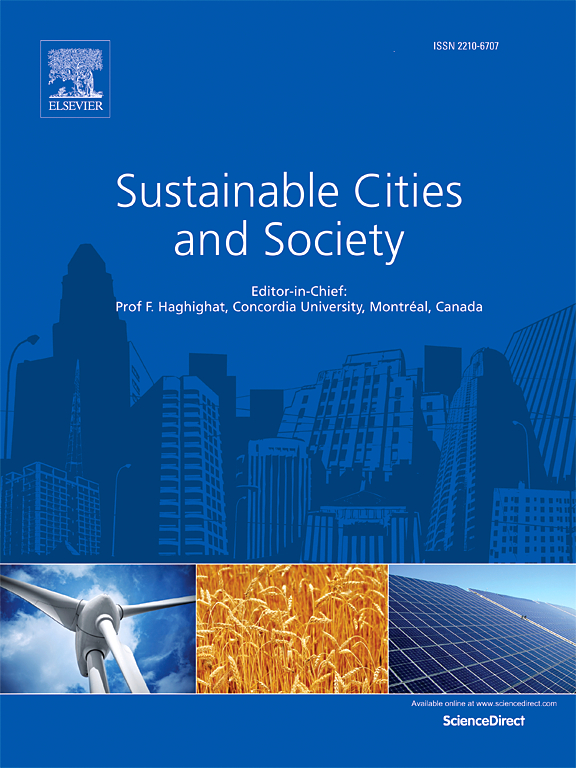铁路网的扩张减少了东京25年来的空气污染
IF 10.5
1区 工程技术
Q1 CONSTRUCTION & BUILDING TECHNOLOGY
引用次数: 0
摘要
我们通过研究日本25年来的铁路网扩张,探讨了铁路基础设施对空气污染的长期影响。利用差异中的差异、市场准入的回归分析和工具变量策略,我们确定了铁路发展与空气质量改善之间的因果关系。结果表明:铁路扩建显著降低悬浮颗粒物(SPM) 9.576% ~ 21.65%,二氧化氮(NO2) 1.401% ~ 1.546%;结果还表明,随着这些扩张,乘客人数增加,向铁路的转变。改善空气质量带来的健康效益价值在98271万至16151.5万美元之间,约占总建筑成本的1.426%至2.342%。最显著的改善出现在最初SPM水平较高的地区,而中央商务区的效益进一步下降。我们的模拟表明,铁路扩建的好处将持续存在,主张将铁路网络的持续发展作为促进环境和公共健康的可持续战略。本文章由计算机程序翻译,如有差异,请以英文原文为准。
Railway network expansion reduces air pollution in Tokyo over 25 years
We explore the long-term impact of railway infrastructure on air pollution by examining Japan’s railway network expansion over a 25-year period. Using Difference-in-Differences, regression analysis with market access, and instrumental variables strategies, we identify a causal link between railway development and improved air quality. Our findings show that railway expansion significantly reduces Suspended Particulate Matter (SPM) by 9.576 to 21.65 and Nitrogen Dioxide () by 1.401 to 1.546. Results also indicate increased ridership and a shift towards railways following these expansions. Improved air quality translates to health benefits valued between 98.271 and 161.515 million USD, or approximately 1.426 to 2.342 of total construction costs. The most significant improvements are seen in areas with initially high SPM levels, with diminishing benefits noted further from central business districts. Our simulations suggest that the benefits of railway expansions will persist, advocating for continued development of railway networks as a sustainable strategy for environmental and public health enhancement.
求助全文
通过发布文献求助,成功后即可免费获取论文全文。
去求助
来源期刊

Sustainable Cities and Society
Social Sciences-Geography, Planning and Development
CiteScore
22.00
自引率
13.70%
发文量
810
审稿时长
27 days
期刊介绍:
Sustainable Cities and Society (SCS) is an international journal that focuses on fundamental and applied research to promote environmentally sustainable and socially resilient cities. The journal welcomes cross-cutting, multi-disciplinary research in various areas, including:
1. Smart cities and resilient environments;
2. Alternative/clean energy sources, energy distribution, distributed energy generation, and energy demand reduction/management;
3. Monitoring and improving air quality in built environment and cities (e.g., healthy built environment and air quality management);
4. Energy efficient, low/zero carbon, and green buildings/communities;
5. Climate change mitigation and adaptation in urban environments;
6. Green infrastructure and BMPs;
7. Environmental Footprint accounting and management;
8. Urban agriculture and forestry;
9. ICT, smart grid and intelligent infrastructure;
10. Urban design/planning, regulations, legislation, certification, economics, and policy;
11. Social aspects, impacts and resiliency of cities;
12. Behavior monitoring, analysis and change within urban communities;
13. Health monitoring and improvement;
14. Nexus issues related to sustainable cities and societies;
15. Smart city governance;
16. Decision Support Systems for trade-off and uncertainty analysis for improved management of cities and society;
17. Big data, machine learning, and artificial intelligence applications and case studies;
18. Critical infrastructure protection, including security, privacy, forensics, and reliability issues of cyber-physical systems.
19. Water footprint reduction and urban water distribution, harvesting, treatment, reuse and management;
20. Waste reduction and recycling;
21. Wastewater collection, treatment and recycling;
22. Smart, clean and healthy transportation systems and infrastructure;
 求助内容:
求助内容: 应助结果提醒方式:
应助结果提醒方式:


